| |
The white lily is Kitakami's city flower. 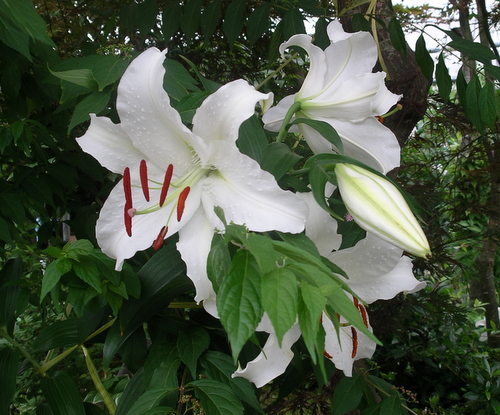 These ones are growing in a neighbor's yard. They also grow wild along the mountain roads in the area.
Just on the other side of the Akita border, there's a beautiful hot spring valley. Small, old, rustic ryokan (traditional Japanese inns) and bathhouses line the one street running through town. The baths are hot and cloudy with minerals. The ryokan provide gorgeous views of the lush mountainside. It's a fantastic place to relax in the comfort of your room, sated with wonderful, fresh Akita food. To get there, all you have to do is get in your car and drive through clouds of poisonous gas, just beyond the signs warning you to keep moving, lest you be overcome and die. 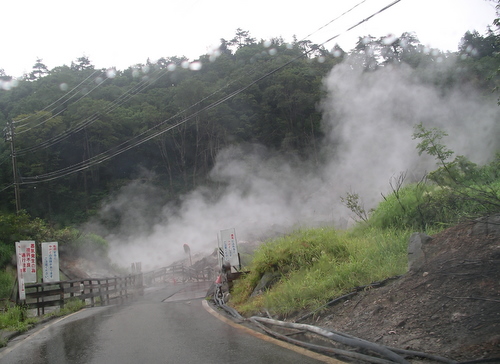
One of the loudspeaker trucks was circulating this morning. Its announcement was different from the others because it had traditional-sounding music playing in the background ― similar to the ramen truck, but peaceful rather than creepy. It turned out to be a guy selling watermelons from the back of a covered truck. Naturally, we had to take advantage of this totally Japanese experience and buy one. 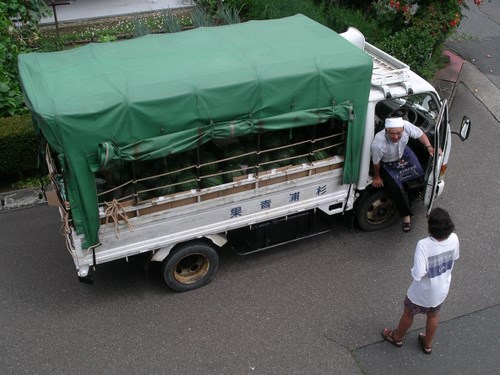 Totally worth the 900 yen.
In a nod to Kitakami's famous Onikenbai dance, a phone booth downtown has a pair of demon masks mounted above its doors. 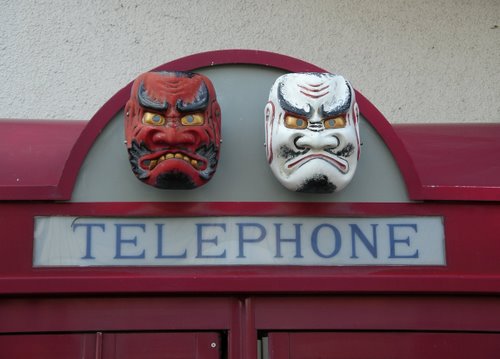 You might not want to try stealing 100 yen coins from the phones inside.
Friday, July 25, 2008, 1:19 AM GeneralPosted by stefanie Until last night, things had settled down for us, geologically speaking. The aftershocks from the Iwate-Miyagi earthquake had pretty much stopped. Small tremors occurred occasionally, but nothing really out of the ordinary ― a shindo 3 here, a shindo 2 there. Until last night, when the glasses started rattling and the ceiling lights started bouncing, the prelude to a whooshing roar as our second big earthquake intensified. The quake registered as a 6.8 on the Richter scale, with its epicenter about 65 km from here, east of Morioka. Areas close to the epicenter had landslides and some fires; Kitakami escaped relatively unscathed once again. JR East didn't resume train service until about 1:45 pm, but people who needed to travel simply found other ways, and we went on with our lives. There are two attitudes frequently associated with the Japanese people. One is ganbaru ― perseverance, or striving to do one's best. It is expressed in many ways: as a spirited cry during a sporting event, as an exhortation from one classmate to another struggling with an answer, as a soft bit of encouragement from a mother to an injured child. The other is shou ga nai ― there is nothing to be done, or there is no help for it. It is an attitude of acceptance that there are things over which we have no control, and all we can do is let the chips fall where they may. Over the millennia during which the Japanese formed these attitudes, the earthquakes must have played a role. What, after all, can you do about the earth moving, splitting and collapsing as it does? You can give up, which at best makes you a quivering mound of fear every time the house creaks and at worst leaves you with a life and community possibly in ruins. It doesn't prevent the quakes from happening. You must persevere. You must go on. And you must do so with every expectation that the earth will awaken again. When Mother Earth needs to let off some stress by shifting plates around ― there is nothing to be done. You can only accept that it will happen, and persevere when it does.
After a little over a year on the Japanese cooking scene, I've gotten quite an education. I'm a bit of a purist, so I've been focusing on using seasonal ingredients and learning traditional techniques. As a general rule, I prefer to avoid processed things ― for example, I won't use okonomiyaki mix because while making it from scratch is a little more involved and itchy (stupid nagaimo juice), it's still really easy and the payoff is good. I don't mind fiddly, time-consuming, involved things if the end result is worth it. Which is why my first experience with making chirashi-zushi was such a downer. Chirashi-zushi is essentially vinegared rice with seasoned things mixed in and other things scattered on top. Making it from scratch took the better part of an evening: cooking and seasoning each of the ingredients individually, vinegaring the rice and fanning it while stirring, and finally mixing and topping it with the other ingredients. It looked pretty, but it was really underwhelming. Some of the ingredients were undercooked and strongly seasoned, while others were overcooked and strongly seasoned, almost to the point of being candied. The latter point, though, provided a valuable lesson: if you're cooking a mixture involving soy sauce and mirin and it starts to smell like battery acid, it's too far gone. I shared my sad story of battery-acid-smelling disappointment with a friend. She laughed, then shared her secret. "I'm too busy to make it from scratch," she said. "I use a mix." A mix?! Horrors! What about tradition, the need to use fresh ingredients, the attention to detail so commonly associated with Japanese cooking? Well, you can get freshness when you choose your toppings; as it turns out, a bag of vinegared vegetables and a pouch of shredded nori seaweed and sesame seeds comprise the mix. The result? 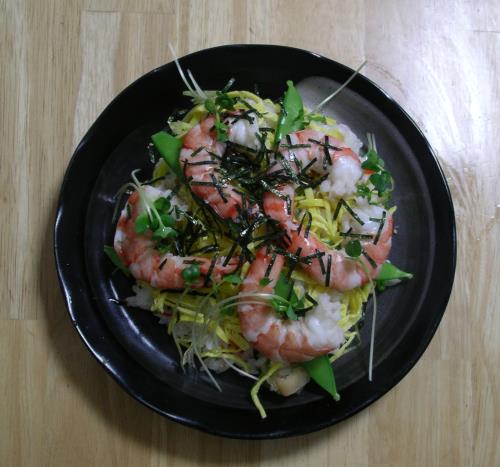 Mix chirashi was vastly superior to my scratch version. And if it's good enough for the natives, it's good enough for me.
Where the Green Fern Grows
A fern growing in the Juniko area (in Aomori Prefecture) of the Shirakami Mountains. 
[ add comment ] permalink
Somewhere across that expanse of water (seen from the Goishi Kaigan on the Iwate coast) lie the shores of California. 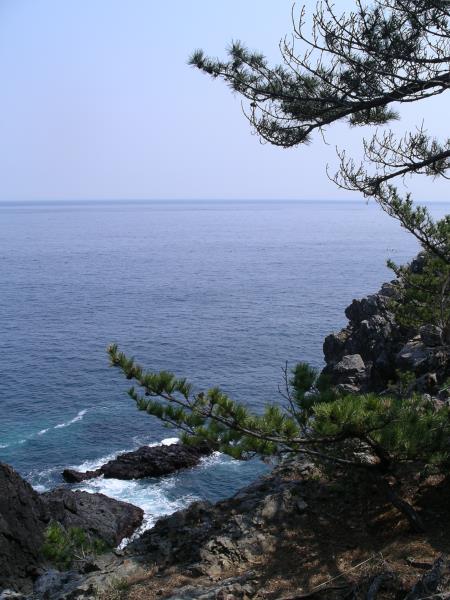
Do you remember the Pokemon craze from a few years ago? The Japanese sure do. In fact, it's still a craze here. It's even popular enough to be at the center of a joint advertising campaign between JR East and All Nippon Airways. From today until September 15, you can ride a bullet train decorated with your favorite characters. It all kicked off when one of the decorated trains (actually, a coupled set of two trains, an E3 and an E2) headed north from Tokyo, stopping at Kitakami on its way to Morioka. 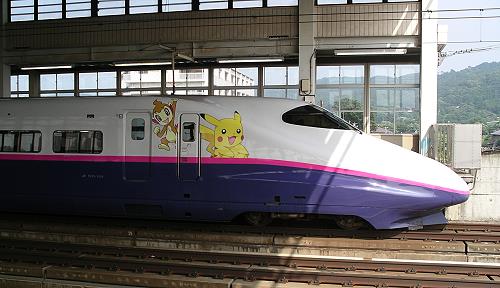 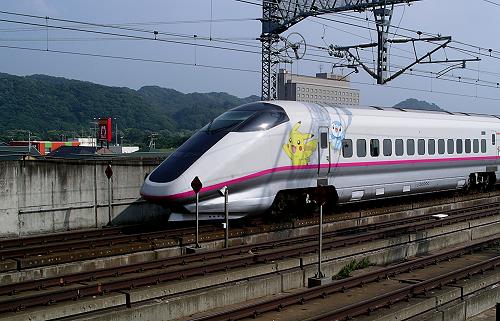
To remind motorists to watch for older people in the street, these signs appear in certain areas: 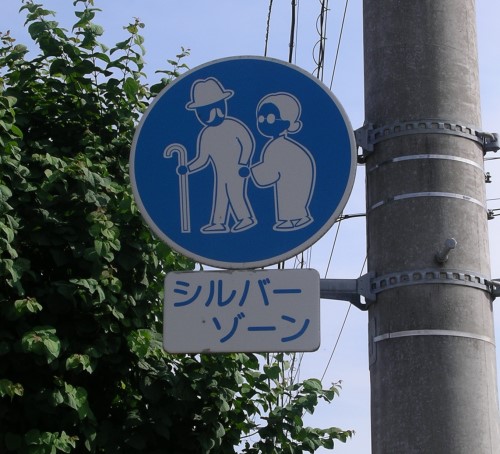 Those areas are called "Silver Zones." Aren't the signs cute?
Back Next
|
|








 Calendar
Calendar




